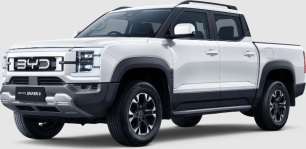The cabin is massive, with the Shark making the most of its boxy dimensions, and it also offers impressive adjustability for the driver and front passenger seats.
The high seating position provides a commanding view of the road with great overall visibility thanks to large mirrors and expansive window real-estate.
Entry and egress is bolstered by large side-steps and a multitude of grab-handles in the A-pillar and centre console and for long trips the seats are some of the most comfortable in the class.
Storage is also plentiful, with large bottle holders and pockets in the doors, a further two with adjustable ridges in the centre console, alongside a wireless phone charger and an immense armrest storage box.
The console is also home to an array of buttons for various drive-modes alongside the shift lever, but in terms of multimedia functions there’s only a physical on-off switch, a de-fog shortcut switch for the climate and a volume dial.
In what could be a bit of a deal-breaker for some, the rest of this car’s many functions are controlled exclusively by the touchscreen, which can, at times, have a confusing array of menus.
For example, the controls for fan speed, temperature, recirculate, and various other functions like the regenerative braking and steering modes are touchscreen only.
The climate screen is at least straightforward, but other features require some figuring out as the array of menus are inconsistently labelled (as with many other Chinese vehicles).
It’s not as bad as Tesla, at least offering a digital instrument cluster, and some physical control features, but it might be a bridge too far for some ute buyers.
Additionally, the software is okay but not great. It’s fast and looks reasonably good which beats out most Chinese rivals, but it’s a pretty blatant Android reskin which feels a little unfinished around the edges.
Particularly the digital dash looks pretty ordinary and only has one theme, with the information overload it offers on either side of the speedo being of questionable value.
Hopping in the second row it feels as though the Shark 6 offers unrivalled space compared to the usual crop of dual-cabs. I have leagues of kneeroom behind my own (182cm) driving position, and the cabin feels as wide as a big SUV also featuring a flat floor, making the middle position usable by an adult. Headroom is also good and the plush trims continue, too.
While the rear row also scores big grab handles and makes use of those side-steps, it also has an odd issue with the thickness of the B-pillar eating into entry space. I got my feet caught on it despite the amount of room you have once inside. Weird.
Storage for rear passengers is also good, with a large bottle holder in each door, and two more large ones in the drop-down armrest. There are also soft pockets on the backs of the front seats, adjustable air vents, a USB-C and USB-A port as well as a full-size household power outlet.
Additionally, the rear bench has some flexibility built in. You can raise the base to make for a larger storage area if you don’t need the seats, or you can fold the back forward revealing some limited space behind (good for charging cables, towbars and your V2L adapter, for example).
The tray measures 1200 litres according to BYD, with a large square space provided between the wheel arches. Keep an eye out for a future payload test for more on this, but the Shark 6 has a payload of 790kg.
Not bad considering it also has to lug around 30kWh of battery packs under the floor, but it’s also a far cry from the coveted one tonne payload rating achieved by some rivals.
However, the Shark 6 offers some other neat additions, like built-in LED lighting for the tray area and no less than three full-size power outlets which could be good for powering worksite equipment or household appliances even when you’re far from the power grid.
Towing specs are also off-the pace, as you might expect. The Shark 6 can tow 2500kg braked, which is a full tonne down on the accepted 3500kg segment standard, so it’s worth considering this if there’s the possibility you’ll need to tow significant loads.

